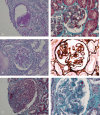Kidney diseases associated with anti-vascular endothelial growth factor (VEGF): an 8-year observational study at a single center
- PMID: 25500702
- PMCID: PMC4602430
- DOI: 10.1097/MD.0000000000000207
Kidney diseases associated with anti-vascular endothelial growth factor (VEGF): an 8-year observational study at a single center
Erratum in
- Medicine (Baltimore). 2014 Nov;93(24):414
Abstract
Expanded clinical experience with patients taking antiangiogenic compounds has come with increasing recognition of the renal adverse effects. Because renal histology is rarely sought in those patients, the renal consequences are underestimated. Antiangiogenic-treated-cancer patients, who had a renal biopsy for renal adverse effects from 2006 to 2013, were included in the current study. Clinical features and renal histologic findings were reviewed. Our cohort was 100 patients (58 women) with biopsy-proven kidney disease using anti-vascular endothelial growth factor (VEGF) therapy with a mean age of 59.8 years (range, 20-85 yr). Patients were referred for proteinuria, hypertension, and/or renal insufficiency. Kidney biopsy was performed 6.87 ± 7.18 months after the beginning of treatment. Seventy-three patients experienced renal thrombotic microangiopathy (TMA) and 27 patients had variable glomerulopathies, mainly minimal change disease and/or collapsing-like focal segmental glomerulosclerosis (MCN/cFSGS). MCN/cFSGS-like lesions developed mainly with tyrosine-kinase inhibitors, whereas TMA complicated anti-VEGF ligand. Thirty-one percent of TMA patients had proteinuria up to 1 g/24 h. Half of TMA cases are exclusively renal localized. Pathologic TMA features are intraglomerular exclusively. MCN/cFSGS glomeruli displayed a high abundance of KI-67, but synaptopodin was not detected. Conversely, TMA glomeruli exhibited a normal abundance of synaptopodin-like control, whereas KI-67 was absent. Median follow-up was 12 months (range, 1-80 mo). Fifty-four patients died due to cancer progression. Hypertension and proteinuria resolved following drug discontinuation and antihypertensive agents. No patient developed severe renal failure requiring dialysis. Drug continuation or reintroduction resulted in a more severe recurrence of TMA in 3 out of 4 patients requiring maintenance of anti-VEGF agents despite renal TMA. In conclusion, TMA and MCN/cFSGS are the most frequent forms of renal involvement under anti-VEGF therapy. Careful risk-benefit assessment for individual patients should take into account risk factors related to the host and the tumor.
Conflict of interest statement
Financial support and conflicts of interest: The authors have no funding or conflicts of interest to disclose.
Figures


References
-
- Albaqumi M, Barisoni L. Current views on collapsing glomerulopathy. J Am Soc Nephrol. 2008; 19:1276–1281. - PubMed
-
- Barakat RK, Singh N, Lal R, et al. Interstitial nephritis secondary to bevacizumab treatment in metastatic leiomyosarcoma. Ann Pharmacother. 2007; 41:707–710. - PubMed
-
- Barisoni L, Kriz W, Mundel P, D’Agati V. The dysregulated podocyte phenotype: a novel concept in the pathogenesis of collapsing idiopathic focal segmental glomerulosclerosis and HIV-associated nephropathy. J Am Soc Nephrol. 1999; 10:51–61. - PubMed
-
- Bhadada SV, Goyal BR, Patel MM. Angiogenic targets for potential disorders. Fundam Clin Pharmacol. 2010; 25:29–47. - PubMed
-
- Bollee G, Patey N, Cazajous G, et al. Thrombotic microangiopathy secondary to VEGF pathway inhibition by sunitinib. Nephrol Dial Transplant. 2009; 24:682–685. - PubMed
Publication types
MeSH terms
Substances
LinkOut - more resources
Full Text Sources
Other Literature Sources
Medical

